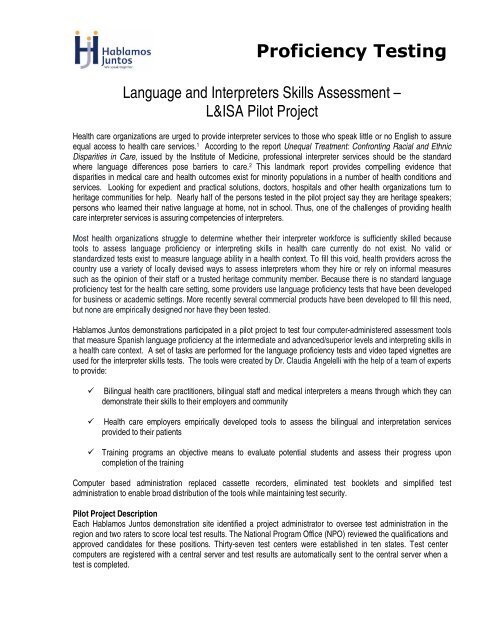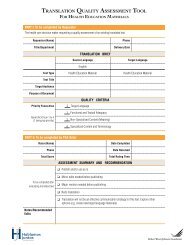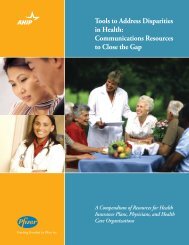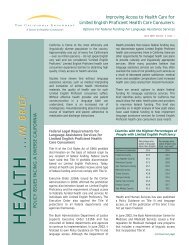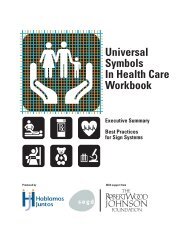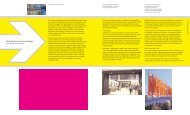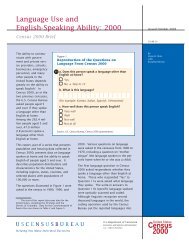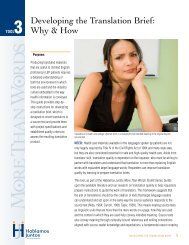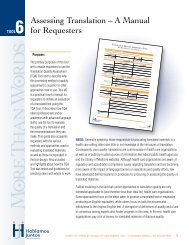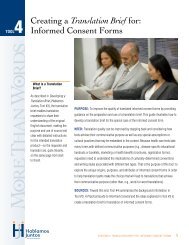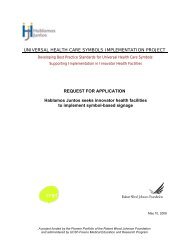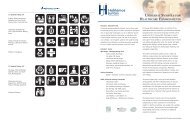Language and Interpreter Skills Assessment - Hablamos Juntos
Language and Interpreter Skills Assessment - Hablamos Juntos
Language and Interpreter Skills Assessment - Hablamos Juntos
You also want an ePaper? Increase the reach of your titles
YUMPU automatically turns print PDFs into web optimized ePapers that Google loves.
Proficiency Testing<br />
<strong>Language</strong> <strong>and</strong> <strong>Interpreter</strong>s <strong>Skills</strong> <strong>Assessment</strong> –<br />
L&ISA Pilot Project<br />
Health care organizations are urged to provide interpreter services to those who speak little or no English to assure<br />
equal access to health care services. 1 According to the report Unequal Treatment: Confronting Racial <strong>and</strong> Ethnic<br />
Disparities in Care, issued by the Institute of Medicine, professional interpreter services should be the st<strong>and</strong>ard<br />
where language differences pose barriers to care. 2 This l<strong>and</strong>mark report provides compelling evidence that<br />
disparities in medical care <strong>and</strong> health outcomes exist for minority populations in a number of health conditions <strong>and</strong><br />
services. Looking for expedient <strong>and</strong> practical solutions, doctors, hospitals <strong>and</strong> other health organizations turn to<br />
heritage communities for help. Nearly half of the persons tested in the pilot project say they are heritage speakers;<br />
persons who learned their native language at home, not in school. Thus, one of the challenges of providing health<br />
care interpreter services is assuring competencies of interpreters.<br />
Most health organizations struggle to determine whether their interpreter workforce is sufficiently skilled because<br />
tools to assess language proficiency or interpreting skills in health care currently do not exist. No valid or<br />
st<strong>and</strong>ardized tests exist to measure language ability in a health context. To fill this void, health providers across the<br />
country use a variety of locally devised ways to assess interpreters whom they hire or rely on informal measures<br />
such as the opinion of their staff or a trusted heritage community member. Because there is no st<strong>and</strong>ard language<br />
proficiency test for the health care setting, some providers use language proficiency tests that have been developed<br />
for business or academic settings. More recently several commercial products have been developed to fill this need,<br />
but none are empirically designed nor have they been tested.<br />
<strong>Hablamos</strong> <strong>Juntos</strong> demonstrations participated in a pilot project to test four computer-administered assessment tools<br />
that measure Spanish language proficiency at the intermediate <strong>and</strong> advanced/superior levels <strong>and</strong> interpreting skills in<br />
a health care context. A set of tasks are performed for the language proficiency tests <strong>and</strong> video taped vignettes are<br />
used for the interpreter skills tests. The tools were created by Dr. Claudia Angelelli with the help of a team of experts<br />
to provide:<br />
! Bilingual health care practitioners, bilingual staff <strong>and</strong> medical interpreters a means through which they can<br />
demonstrate their skills to their employers <strong>and</strong> community<br />
! Health care employers empirically developed tools to assess the bilingual <strong>and</strong> interpretation services<br />
provided to their patients<br />
! Training programs an objective means to evaluate potential students <strong>and</strong> assess their progress upon<br />
completion of the training<br />
Computer based administration replaced cassette recorders, eliminated test booklets <strong>and</strong> simplified test<br />
administration to enable broad distribution of the tools while maintaining test security.<br />
Pilot Project Description<br />
Each <strong>Hablamos</strong> <strong>Juntos</strong> demonstration site identified a project administrator to oversee test administration in the<br />
region <strong>and</strong> two raters to score local test results. The National Program Office (NPO) reviewed the qualifications <strong>and</strong><br />
approved c<strong>and</strong>idates for these positions. Thirty-seven test centers were established in ten states. Test center<br />
computers are registered with a central server <strong>and</strong> test results are automatically sent to the central server when a<br />
test is completed.
Health Care for Limited English Proficient Populations<br />
<strong>Hablamos</strong> <strong>Juntos</strong> Lessons Learned<br />
September 30, 2005<br />
Instruction manuals were prepared to guide implementation. One manual provided instructions for downloading the<br />
software <strong>and</strong> registering the test center computers. Another provided instructions for establishing test centers.<br />
Guidelines were provided for recruiting, screening, scheduling, registering <strong>and</strong> administering the four tests. Sample<br />
applications, consent forms <strong>and</strong> scripts for administering each test were included.<br />
Demonstration sites participated in de-bugging the program <strong>and</strong> provided suggestions for software improvements.<br />
The de-bugging process also helped to develop <strong>and</strong> refine test administration procedures for computer<br />
administration.<br />
User Experience<br />
Each grantee developed localized marketing materials for the region where testing is taking place to attract test<br />
c<strong>and</strong>idates. Test center staff members provide an orientation to the testing process <strong>and</strong> how the software program<br />
works. Test takers are told that they are participating in a pilot project; that the tools (administered through a<br />
computer-based audio-visual software program) are new <strong>and</strong> are asked to complete a User Profile at the start of<br />
each test to collect demographic <strong>and</strong> background data. The need for confidentiality about the specific test content is<br />
stressed <strong>and</strong> test takers are asked to sign a confidentiality statement to ensure security.<br />
Scoring<br />
Trained raters score each test twice. Raters attended a two-day workshop to learn about test administration <strong>and</strong><br />
scoring <strong>and</strong> received a manual with scoring guidelines <strong>and</strong> a rubric to score the four different tests on-line. Scoring<br />
is completed on a scoring rubric embedded with audio files. Raters access test results, click on the scoring rubric to<br />
listen to test results, score the test <strong>and</strong> submit scoring results via the Internet. The identity of the test taker is not<br />
made available to the raters.<br />
Local raters are able to access local test results from a central server. National Program Office raters score tests<br />
from all test centers across the country. Dual scoring enables the program to evaluate the quality <strong>and</strong> consistency of<br />
ratings by individual raters. National level scores will also enable the development of benchmarks for ranking<br />
individual results.<br />
<strong>Skills</strong> Measured<br />
C<strong>and</strong>idates are asked to complete one language<br />
proficiency test (Intermediate or Advanced/Superior)<br />
<strong>and</strong> the <strong>Interpreter</strong> Readiness Pre-Test at the first visit.<br />
The <strong>Interpreter</strong> Readiness Final Test is scheduled for a<br />
subsequent date. Each test measures a set of skills at<br />
different levels. Listening <strong>and</strong> reading comprehension,<br />
literacy in Spanish <strong>and</strong> speaking are tested with the<br />
intermediate language proficiency tool. The advanced<br />
proficiency test measures speaking at different registers<br />
or ways of speaking as well as the four skills listed<br />
above but at more advanced levels. Both <strong>Interpreter</strong><br />
Readiness tools test attention to detail <strong>and</strong> sequences,<br />
social <strong>and</strong> cultural appropriateness, general language<br />
ability, <strong>and</strong> terminology. In addition, the pre-test<br />
measures speaking <strong>and</strong> the post-test includes a test on<br />
ability to sight-translate a consent form. The table<br />
shows skills measured by each of the four tests.<br />
<strong>Language</strong><br />
Prof iciency<br />
<strong>Interpreter</strong><br />
Readiness<br />
Exam Title<br />
Intermediate Advanced Pre Final<br />
At t ent ion t o det ails <strong>and</strong> sequences x x<br />
Cult ural/ Social appropriat eness x x<br />
General language ability - Final<br />
x<br />
List ening comprehension x x<br />
Spanish lit eracy x x<br />
Reading comprehension - general x x<br />
Speaking x x x<br />
Speaking + Regist er x x<br />
Terminology x x<br />
General language ability - Pre Test<br />
x<br />
Reading comprehension - Consent Forms<br />
x<br />
- 2 -
Health Care for Limited English Proficient Populations<br />
<strong>Hablamos</strong> <strong>Juntos</strong> Lessons Learned<br />
September 30, 2005<br />
Individualized Self Improvement Plans<br />
Since this is a national pilot evaluating a newly developed tool, test results in the form of numeric scores were not<br />
provided initially. Instead, the National Program Office gave test takers an Individualized Improvement Plan for each<br />
assessment test taken. The improvement plans were individualized based on the results of the assessment. This<br />
document identifies strengths <strong>and</strong> weaknesses <strong>and</strong> provides suggestions to improve current skills. Individual results<br />
cannot be released without written consent.<br />
Summary of all test takers<br />
Pilot Results<br />
The typical participant, based on the highest<br />
percentages in the categories reviewed, was a<br />
woman between the age of 31 <strong>and</strong> 40 from the<br />
United States. Her primary language was Spanish<br />
<strong>and</strong> she was educated only in the United States for<br />
up to 12 years. If working with a type of health<br />
agency <strong>and</strong> she was employed by a hospital. A<br />
third of the participants were asked to interpret as a<br />
child.<br />
The c<strong>and</strong>idates tested confirm that a large number,<br />
44% of interpreters are heritage speakers,<br />
receiving no formal education in their native<br />
language. This has significant implications for<br />
• A total of 882 tests were administered.<br />
• 80% of all participants were female<br />
• Most participants were between the ages of 21 <strong>and</strong> 50, with 30%<br />
between the ages of 31 to 40.<br />
• Participants were born in 22 different countries. 44% of the<br />
participants were born in the United States. The next most common<br />
country of birth was Mexico with 18% of the participants. None of the<br />
remaining 20 countries had a frequency higher than 5%.<br />
• For 60% of the participants, Spanish was their primary language.<br />
English was for 37%<br />
• 44% of the participants had no schooling outside the United States.<br />
Of those who did, most had schooling up to 12 years.<br />
• 28% of the participants were employed by a hospital, which was the<br />
highest percentage among the employers listed. 36% claimed some<br />
other, non-listed employer.<br />
language proficiency in their native language, particularly reading <strong>and</strong> writing skills. The distribution of participants in<br />
the category of years of school completed in the United States was relatively uniform: 23% of the participants<br />
completed up to 12 years of school in the US; 22% completed 2 years of college; 13% had 4 years of college, <strong>and</strong><br />
16% had 5 or more years of college education in the US. Seventeen percent of the participants had no years of<br />
education in the US.<br />
Frequency<br />
70<br />
60<br />
50<br />
40<br />
30<br />
20<br />
10<br />
0<br />
<strong>Language</strong> Proficiency<br />
Advanced/Superior<br />
5 10 15 20 25 30 More<br />
Scores Ranges<br />
<strong>Language</strong> Proficiency <strong>Assessment</strong>s<br />
A total of 195 tests Advanced <strong>and</strong> 267 Intermediate test were<br />
administered during the pilot. Participants scored the lowest using the<br />
advanced <strong>Language</strong> Proficiency tool, scoring on average 53%.<br />
Participants scored 50% or below in three of the five skill sets tested by<br />
this tool, Listening comprehension, speaking, <strong>and</strong> Speaking + Register<br />
which is a skill not tested by the intermediate tool. For the advanced<br />
language proficiency test, the scores were within a range of 5 to 30<br />
inclusive out of a possible 30. The distribution resembled a bell curve<br />
with the majority of the scores falling within the 15 to 20 range, inclusive.<br />
The peak frequency of 64 was at a score of 15.<br />
Fewer participants taking the advanced test were born in the United States (33% compared to 44%); slightly more<br />
(67% compared to 60%) considered Spanish their primary language <strong>and</strong> fewer (28% compared to 44%) had no<br />
schooling outside the United States<br />
- 3 -
Health Care for Limited English Proficient Populations<br />
<strong>Hablamos</strong> <strong>Juntos</strong> Lessons Learned<br />
September 30, 2005<br />
Participants scored the highest using the intermediate <strong>Language</strong><br />
Proficiency tool, scoring on average 70%. Participants had among the<br />
highest relative scores within the skill set tested by this tool, scoring<br />
above 70% in Listening Comprehension, Spanish Literacy, <strong>and</strong> Reading<br />
Comprehension-General. For the intermediate language proficiency test,<br />
the scores were within a range of 5 to 40 inclusive out of a possible 40.<br />
The trend showed a general increase in frequency over the score range<br />
of 5 to 35 inclusive, with the peak frequency of 103 at the score of 35.<br />
Frequency<br />
120<br />
100<br />
80<br />
60<br />
40<br />
20<br />
<strong>Language</strong> Proficiency<br />
Intermediate<br />
5 10 15 20 25 30 35 40 More<br />
<strong>Interpreter</strong> Readiness <strong>Assessment</strong>s<br />
Scores Ranges<br />
The pilot included two tests to assess interpreter readiness, the Pre-test<br />
which was designed to assess readiness <strong>and</strong> the Final test which was developed to assess interpreter skills after the<br />
completion of a training program. A total of 357 <strong>Interpreter</strong> Readiness Pre-test <strong>and</strong> 63 Final tests were administered.<br />
The typical participant that took the <strong>Interpreter</strong> Readiness Final test, based on the highest percentages in the<br />
categories reviewed, was a woman between the age of 21 <strong>and</strong> 30 born in the United States. Her primary language<br />
was Spanish <strong>and</strong> she was educated only in the United States for up to 2 years of college. If working with a type of<br />
health agency, she was employed by a hospital.<br />
<strong>Interpreter</strong> Readiness Final Test<br />
Participants scored on average nearly<br />
7% lower on the <strong>Interpreter</strong><br />
10<br />
Readiness Final test as compared to<br />
5<br />
the <strong>Interpreter</strong> Readiness Pre test.<br />
0<br />
For each common skill tested by both<br />
35 40 45 50 55 60 65 70 75 80 85 90 95 100 105 110 115 120 125 More<br />
Scores Ranges<br />
these tools, participants scored lower<br />
on the final <strong>Interpreter</strong> Readiness test<br />
than the pre <strong>Interpreter</strong> Readiness test. For example, the average pre test scores in Attention to details <strong>and</strong><br />
sequences, Cultural/Social appropriateness, <strong>and</strong> Terminology were 66%, 63%, <strong>and</strong> 63% respectively whereas in the<br />
final test, the scores in the same categories were 62%, 57%, <strong>and</strong> 58% respectively.<br />
Frequency<br />
For the <strong>Interpreter</strong> Readiness final tests, the scores were within a range of 35 to 125 inclusive out of a possible 140.<br />
There was a r<strong>and</strong>om distribution of scores with frequencies of 6 or higher at 7 different scores. The highest frequency<br />
was 8 which corresponded to a score of 95. Slightly fewer participants taking the advanced test were born in the<br />
United States (40% compared to 44%) <strong>and</strong> more had no schooling outside the United States (48% compared to<br />
44%). Heritage speakers acquire native language ability, learning Spanish in the home.<br />
0<br />
For the <strong>Interpreter</strong> Readiness pre test, the scores were<br />
within a range of 10 to 70 inclusive out of a possible 72.<br />
The scores generally aligned with a bell curve, with the<br />
highest number of scores in the 50 to 60 range,<br />
inclusive. The highest frequency was 86 which<br />
corresponded to a score of 55.<br />
For a single category, participants scored the highest in<br />
Reading comprehension-consent forms which is tested<br />
by the <strong>Interpreter</strong> Readiness final test. Scores were on<br />
average 80% in this category.<br />
Frequency<br />
100<br />
90<br />
80<br />
70<br />
60<br />
50<br />
40<br />
30<br />
20<br />
10<br />
0<br />
<strong>Interpreter</strong> Readiness Pre Test<br />
5 10 15 20 25 30 35 40 45 50 55 60 65 70<br />
Scores Ranges<br />
The turnover rate for interpreters is high <strong>and</strong> most receive little to no training for the job. Forty percent of the<br />
participants tested for interpreter readiness reported having one year or less in health care experience <strong>and</strong> near<br />
- 4 -
Health Care for Limited English Proficient Populations<br />
<strong>Hablamos</strong> <strong>Juntos</strong> Lessons Learned<br />
September 30, 2005<br />
three-fourths (74%) reported having worked 5 years or less as a health care interpreter. Over half of participants<br />
tested (56%) had not received training to work as an interpreter; 21% received less than 40 hours of training. Only<br />
13 or 3% of the sample reported more than 100 hours of interpreter training. Combined these result illustrate the<br />
importance of testing <strong>and</strong> training interpreters.<br />
Test Development<br />
The tests used for this project were developed by Claudia Angelelli, Ph.D. Dr. Angelelli worked with a panel of<br />
experts including Dr. Guadalupe Valdes, Stanford University (Heritage speakers, Bilingualism <strong>and</strong> Testing), Dr.<br />
Edward Haertel, Stanford University (Design of Measurement Instruments; Item Analysis; Statistics), Dr. Mary Ann<br />
Lyman-Haeger, San Diego State University (<strong>Language</strong> Testing; Testing <strong>and</strong> Technology), Prof. Christian Degueldre,<br />
Monterey Institute of International Studies (Translation <strong>and</strong> Interpreting) <strong>and</strong> Dr. Jean Turner (<strong>Language</strong> Testing,<br />
Applied Linguistics) to design the Spanish language proficiency <strong>and</strong> pre <strong>and</strong> post interpreter readiness assessment<br />
tools used in the L&ISA program. Three tools were developed for Connecting Worlds with funding by The California<br />
Endowment. The fourth tool developed for <strong>Hablamos</strong> <strong>Juntos</strong>, uses the same design to assess for high, medium, low<br />
competency at the intermediate Spanish level.<br />
1 Perkins J. (2003) Ensuring Linguistic Access in Health Care Settings: An Overview of Current Legal Rights <strong>and</strong><br />
Responsibilities. Available at http://www.kff.org/uninsured/loader.cfmurl=/commonspot/security/getfile.cfm&pageID=22093<br />
(8/29/2005 10:28 PM); <strong>and</strong> Presidential Executive Order 13166 (2000) “Improving Access to Services for Persons with<br />
Limited English Proficiency.” Federal Register 65, No. 159:50121. Available at<br />
http://www.dol.gov/oasam/regs/statutes/Eo13166.htm (8/29/2005 10:31 PM)<br />
2 Institute of Medicine (2003) Unequal Treatment: Confronting Racial <strong>and</strong> Ethnic Disparities in Health Care, Editors, Smedley, B.<br />
D, Stith, A. Y. <strong>and</strong> A. R. Nelson, Committee on Underst<strong>and</strong>ing <strong>and</strong> Eliminating Racial <strong>and</strong> Ethnic Disparities in Health<br />
Care, National Academy Press, Washington, D.C. p. 192<br />
- 5 -


